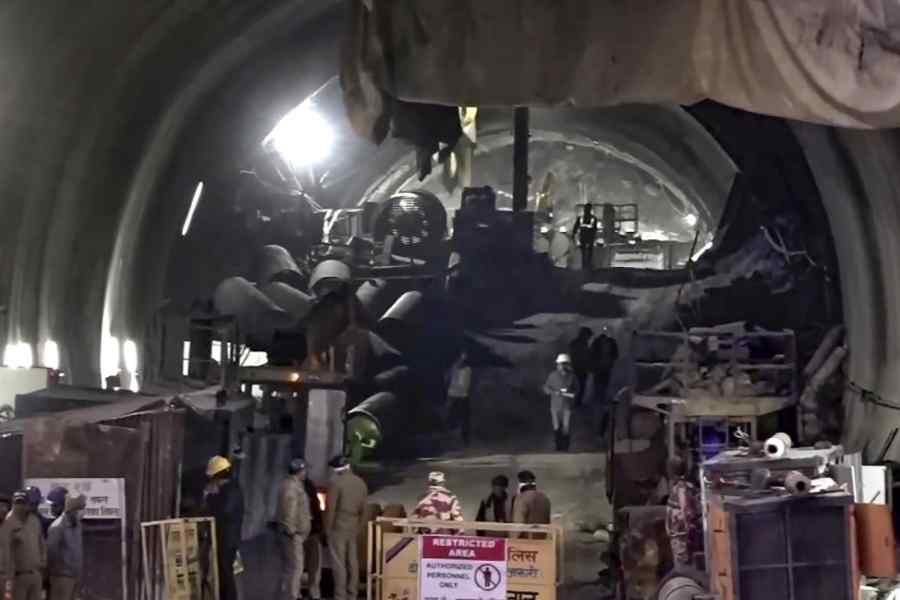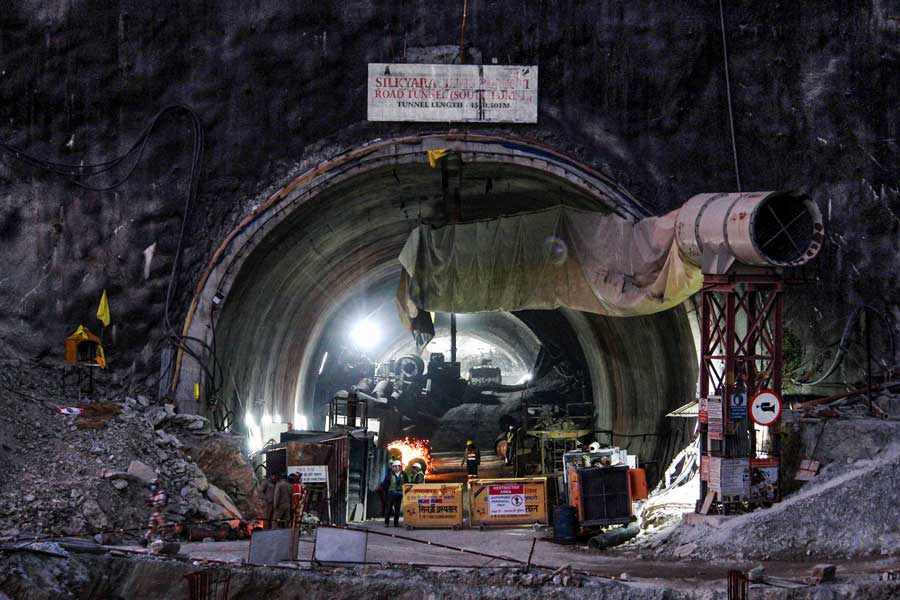Around 4.30pm on Wednesday, only 12 metres of debris separated rescuers from the 41 labourers trapped inside the collapsed Uttarkashi tunnel since November 12.
Officials informed journalists that 45 metres of debris had been cleared and seven steel hume pipes of 6 metres each inserted one after the other to create a passage for the workers to crawl out of the Silkyara tunnel. A 57-metre stretch of the under-construction tunnel had collapsed early on Sunday morning following a landslide, trapping the 41 labourers.
Ambulances have been brought and other arrangements are being made to take the labourers to the district hospital, as soon as they are brought out, and from there to the All India Institute of Medical Sciences (AIIMS), Rishikesh, if needed.
Bhaskar Khulbe, former adviser to Prime Minister Narendra Modi and officer-on-special duty in the Uttarakhand tourism department, told reporters at 4.30pm on Wednesday: “I am happy to inform you that we have drilled six more metres (through the debris). As we would be getting ready after two hours for the next phase of drilling, we hope to get further inside with ease.”
He said a seventh hume pipe of six metres had been pushed through while clearing a total of 45 metres of debris. There is no escape route from the other side of the tunnel as it has not been excavated yet.
While it is taking over an hour in a normal situation to drill a hume pipe through the rubble, work gets held up for days if a big rock or any other solid object comes in the way. Moreover, welding one pipe with another takes more than two hours, and another hour is needed to let the wielded area settle before work can be resumed.
Chief minister Pushkar Singh Dhami tweeted at 5.50pm: “I am reaching Uttarkashi for a spot inspection of the rescue operation on a war footing to safely bring out the labourers trapped in the Silkyara tunnel.”
Sources said Dhami would reach Matali village in Uttarkashi and wait for the operation to end. He plans to receive the labourers near the tunnel before they are taken to the district hospital, the sources said. An ambulance has been kept ready for each labourer. Eyewitnesses said all the ambulances along with doctors and paramedical staff had reached the mouth of the tunnel by evening.”
Initially, the rescuers had pushed three hume pipes and half of the fourth into the debris, but work was halted on November 17 when a rock came in the way of the machine and damaged the auger. It was repaired and put to work again on Tuesday.
Mahmood Ahmed, managing director of the National Highways & Infrastructure Development Corporation Limited, had said early on Wednesday afternoon: “I would stress that we cannot say anything with confidence before reaching 45-50 metres inside. I wish we can push two-three more pipes at the same speed…. We don’t know what is there beyond this level. An iron bar had briefly puzzled us but we were lucky that it had bent from both sides and we could negotiate through it easily. Big hurdles might be waiting for us, but we might get some good news by late night or tomorrow morning if everything goes smoothly.”
He said simultaneous horizontal drilling from the opposite Barkot side of the tunnel had excavated about 7.9 metres.
Neeraj Kharwal, secretary, government of Uttarakhand, said the national and state disaster management response forces had established a permanent mode of communication with the stranded labourers. He suggested that their mental condition was a matter of concern for the government.

Drilling work underway inside the Silkyara tunnel site during the rescue operation of 41 workers trapped inside the tunnel for 10 days, in Uttarkashi district. PTI picture
“As we had informed you (on Tuesday) about a video communication with the trapped labourers, the NDRF and SDRF have established an audio-communication channel with them. Earlier, we were communicating with them through a pipe but now we have sent in a microphone and a speaker connected to a wire. We have a headphone and a microphone on our side to communicate with them continuously,” Kharwal said.
He said doctors had spoken to the trapped workers and enquired about their health. “They complained of constipation and we sent medicines to them. There are also certain aspects of mental health. Our experts and psychiatrists are talking to them one by one to understand their mental health. Otherwise, the team trapped inside is very positive. We are providing them sufficient quantities of food, including cooked items. Undergarments, towels and toothbrushes have also been sent to them,” Kharwal said.
A state government official said on the condition of anonymity: “There was a demand for 41 ambulances, which we have already mobilised. There is a camp of doctors near the tunnel to attend to the workers as they have lived for 11 days in deep fear and without sufficient light. They began receiving proper food only on the tenth day. Most of them have complained of sleep disorder also. All this is bound to have an adverse impact on their brain.”
“We will take them to Uttarkashi District Hospital, where beds and doctors are ready for them. From there, we will airlift them to AIIMS, Rishikesh. Those who belong to other states would be taken to Delhi by flight once the doctors declare them fit. From Delhi, officers of their respective states will take them home,” the official added.
The Construction Workers Federation of India (CWFI) has expressed anguish “at the failure and delay in relief operations”.
“This human-made disastrous accident is a result of the inhuman profit-hungry ‘development’ models and policies pursued by the neoliberal BJP governments. As per the reports and statements of experts, none of the safety measures, including the escape routes necessary in such huge construction projects where hundreds of workers are working day and night, were taken,” said U.P. Joseph, general secretary of the Federation.
“In this and many such cases that have happened in the past, especially in the Himalayan region, the large private construction companies totally neglect the directions of geologists, putting the lives of workers in danger. New tunnelling methods and technologies are not being attempted,” he added.
The CWFI demanded that a case be registered against the company involved in the construction of the tunnel.
Arnold Dix, an Australian engineer who has been helping in the rescue mission since Monday and had planned vertical drilling from above the mountains, was not seen on Wednesday. The Border Roads Organisation had made a road from the Silkyara side up to the mountain for heavy vehicles to carry equipment for a vertical excavation.
Major Naman Narula of the BRO said: “We were asked to make 1,200 metres of road and we completed it on Tuesday night. We don’t know anything else.”











